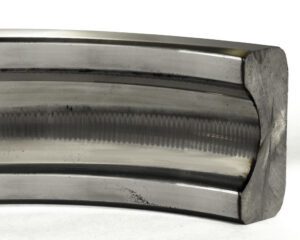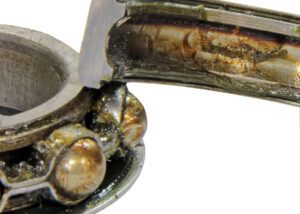
Los motores controlados por VFD están sujetos a dos tipos de tensión del eje: tensión acoplada capacitivamente en el eje y tensión acoplada inductivamente en el eje de extremo a extremo. Independientemente del tipo, una vez que la tensión del eje sea lo suficientemente alta como para superar las propiedades dieléctricas de la grasa para rodamientos, se descargará a lo
largo de la ruta de menor resistencia (por lo general, los rodamientos del motor) hacia la carcasa del motor. Cuando la tensión del eje se descarga formando un arco a través del rodamiento, la temperatura del arco es lo suficientemente alta como para derretir el acero del rodamiento y dañar gravemente la lubricación del mismo.
Estas descargas son tan frecuentes (hasta millones por hora) que en poco tiempo toda la pista del rodamiento queda marcada con incontables picaduras, lo que se conoce como esmerilado. También puede producirse un fenómeno conocido como estriado, que produce resaltes semejantes a los de una tabla de lavar a lo largo de una pista de rodamiento esmerilada. El estriado provoca un ruido y una vibración excesivos y, en los sistemas HVAC, se magnifica y transmite a través de los conductos. Independientemente del tipo de daño que se produzca en los rodamientos o en la pista, el fallo del motor resultante suele tener un coste de muchos miles o incluso decenas de miles de dólares en tiempo de inactividad y pérdida de producción.
